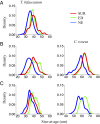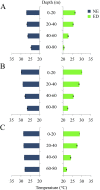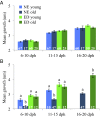Encounter with mesoscale eddies enhances survival to settlement in larval coral reef fishes
- PMID: 27274058
- PMCID: PMC4922168
- DOI: 10.1073/pnas.1601606113
Encounter with mesoscale eddies enhances survival to settlement in larval coral reef fishes
Abstract
Oceanographic features, such as eddies and fronts, enhance and concentrate productivity, generating high-quality patches that dispersive marine larvae may encounter in the plankton. Although broad-scale movement of larvae associated with these features can be captured in biophysical models, direct evidence of processes influencing survival within them, and subsequent effects on population replenishment, are unknown. We sequentially sampled cohorts of coral reef fishes in the plankton and nearshore juvenile habitats in the Straits of Florida and used otolith microstructure analysis to compare growth and size-at-age of larvae collected inside and outside of mesoscale eddies to those that survived to settlement. Larval habitat altered patterns of growth and selective mortality: Thalassoma bifasciatum and Cryptotomus roseus that encountered eddies in the plankton grew faster than larvae outside of eddies and likely experienced higher survival to settlement. During warm periods, T. bifasciatum residing outside of eddies in the oligotrophic Florida Current experienced high mortality and only the slowest growers survived early larval life. Such slow growth is advantageous in nutrient poor habitats when warm temperatures increase metabolic demands but is insufficient for survival beyond the larval stage because only fast-growing larvae successfully settled to reefs. Because larvae arriving to the Straits of Florida from distant sources must spend long periods of time outside of eddies, our results indicate that they have a survival disadvantage. High productivity features such as eddies not only enhance the survival of pelagic larvae, but also potentially increase the contribution of locally spawned larvae to reef populations.
Keywords: mesoscale eddies; otolith microstructure; population connectivity; reef fish settlement; selective mortality.
Conflict of interest statement
The authors declare no conflict of interest.
Figures





References
-
- McGillicudy DJ, Jr, et al. Influence of mesoscale eddies on new production in the Sargasso Sea. Nature. 1998;394(6690):263–266.
-
- Bakun A. 1996. Patterns in the Ocean: Ocean Processes and Marine Population Dynamics. (University of California Sea Grant and Centro de Investigaciones Biológicas de Noroeste, La Paz, Mexico)
-
- Sponaugle S, Lee T, Kourafalou V, Pinkard D. Florida Current frontal eddies and the settlement of coral reef fishes. Limnol Oceanogr. 2005;50(4):1033–1048.
Publication types
MeSH terms
LinkOut - more resources
Full Text Sources
Other Literature Sources

